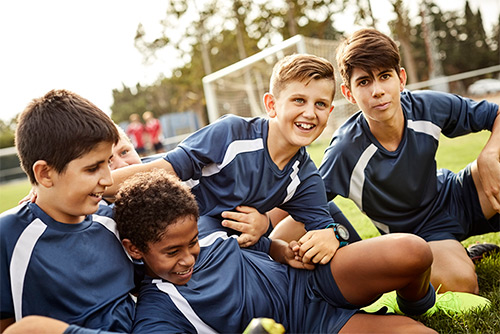
The physiological (and psychological) difference between children and adults make youngsters more susceptible sports injury. However, that does not mean nothing that can be done to prevent or minimize the risk of their occurrence. Here’s how to prevent orthopedic risks in youth sports:
Types of Injuries in Youth Sports:
- Acute Injuries: Cuts and bruises, broken bones or fractures, ligament injuries, and muscle and tendon injuries may occur due to a sudden trauma such as a collision, falls, or abnormal twisting of a limb. Such injuries should be promptly evaluated by a coach or doctor as soon as they occur.
- Overuse injuries: These injuries occur over a prolonged period and are the result of repetitive movements such as pitching or striking the ball resulting in conditions such as shin splints, little league elbow, and Achilles tendonitis. The pain is generally low grade in the early stages but should not be ignored as it leads to chronic ligament and tendon injuries that can be difficult to treat.
Preventing Injuries in Youth Sports:
- Proper Conditioning: A pre-participation health check-up will help determine if your child has the necessary fitness level required to participate in the chosen sport. If not, a progressive workout program should be provided to gradually improve strength and endurance.
- Wearing Protective Gear: Always wear the appropriate and well-fitting gear such as helmets, gloves, shin guards, and padding when participation in sports.
- Play Multiple Sports: Overuse injuries are usually caused when children use the same muscles and apply stress on the same joints while participating in a single sport. Experts recommend that children below the age of 16 years not practice a single sport for more hours in a week than their age in years and instead play different sports to avoid overuse injuries.
- Warm up Before Every Game: Take about 10-20 minutes to warm up the muscles and joints with light jogging and range of motion exercise. This will help loosen stiff muscles and get them ready for the more intense activity during the game.
- Stay Well Hydrated: Vigorous physical activity raises core body temperature. The body responds by sweating which cools the skin and dissipates body heat. However, the fluids lost due to sweating need to be replenished to avoid muscle cramps, heat exhaustion, and stroke. To prevent dehydration drink plenty of water before, during, and after sports.
Dr. David N. Buchalter is a board-certified orthopedic surgeon who trained at the Hospital for Joint Diseases in New York City, one of the largest and most prestigious orthopedic training hospitals in the United States. Dr. Buchalter has performed well over 3,000 total hip and total knee replacements and is a member of the American Association of Hip and Knee Surgeons. Our team of physicians provides an advanced level of care, integrating the newest cutting-edge surgical and nonsurgical techniques, with proven traditional methods of treatments. The physicians at South Palm Orthopedics are committed to providing the highest level of orthopedic care to each and every patient each and every time.

